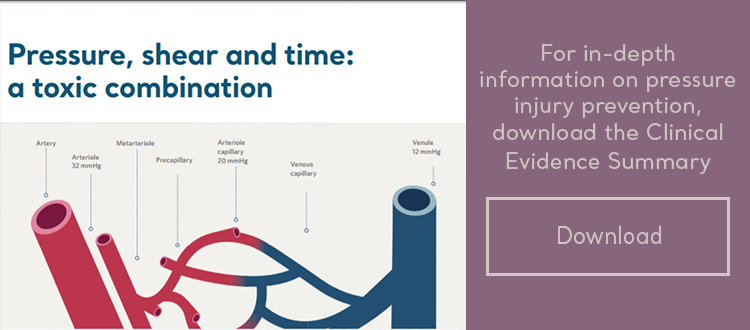For several years the term “bed sores” were used to describe pressure injuries. More recently, the use of this term has been abandoned to reflect the fact that pressure injuries are not just present in those confined to the bed; with a growing appreciation of the need to implement pressure injury prevention strategies outside of the bed.

Previously, past research and practice has focussed on the use of mattresses to treat pressure ulcers, however, extensive periods of bed rest can lead to significant muscle wastage1, cognitive impairement, reduced social interactions, and an increased risk of venous thromboembolism events.
This has led to a significant increase in individuals at risk of pressure injury development spending time out of the bed. However, a study has shown that when sitting in a natural position, the body weight placed over a smaller surface area can lead to a pressure injury developing within one to two hours.2
Pressure injury Prevention Solutions at the Bedside
With an increased focus on moving patients from the bed to the bedside or other social areas, Arjo offer a number of seating solutions to aid pressure injury prevention in these areas:
- ConformX Seat Cushion – The ConformX 24 hour care package offers an optional visco-elastic seat cushion for pressure injury prevention in bed and at the bedside. The ConformX range is a durable, long lasting solution for around-the-clock care.
- Pentaflex Seat Cushion – Like ConformX, Pentaflex offers a 24 hour care package, with an optional castellated foam seat cushion providing pressure injury prevention at the bedside.
- Simulflex Seat Cushion – The Simulflex range is made of high quality polyurethane foam. The optional seat cushion offers an out of bed pressure injury solution.
- AtmosAir® 300P Seat Cushion – The AtmosAir® 300P seat cushion offers a unique, dynamic pressure management system incorporating “open-pressurised” Self-Adjusting Technology™ (SAT) to provide pulsating/controlled air suspension therapy.
- Aura Seat Cushion – The Aura Seat Cushion provides alternating pressure in a seat cushion utilising a separate mini-pump that offers comfort control.
- Auralis Seat Cushion – By simply connecting the Auralis seat cushion to the Auralis MRS pump, automatic system recognition enables 24 hour alternation therapy providing round-the-clock prevention and management of pressure ulcers.
Standing and Raising Aids for Movement to and from the Bedside
For chair bound patients, regular relief of pressure is vital to help protect the skin against tissue damage. In addition to an appropriate pressure redistribution cushion, the use of a standing and raising aids such as Sara Plus or Sara Stedy can facilitate standing to allow regular skin inspection, movement from the bed to a seat, and temporarily relieve the sustained high pressures normally encountered during sitting.
Early Mobilisation for Pressure Injury Prevention
Bed rest not only places patients at an increased risk of pressure injuries and venous thromboembolism events but also reduces pulmonary function. Mobilisation early in the patient’s care pathway is encouraged to help prevent many of these issues and these individuals on bed rest are encouraged to progress to sitting and ambulation as quickly as is tolerable.3
As a leader in Safe Patient Handling solutions, Arjo is committed to helping you address preventable harm in a cost effective manner across the care continuum.
Our Safe Patient Handling solutions for early mobilisation, include:
- Sara Combilizer Patient Positioning and Mobilisation Aid
- Maxi Move Passive Lifter
- Sara Plus Active Lifter
Please contact your local Arjo representative to find out which solution can be best tailored to your needs.
References
1. Parry SM, Puthucheary ZA. (2015). The Impact of Extended Bed Rest on the Musculoskeletal System in the Critical Care Environment. Extrem Physiol Med. 4:16.
2. Kosiak M. (1959). Etiology and Pathology of Ischemic Ulcers. Arch Phys Med Rehabil. 40(2):62-69.
3. National Pressure Ulcer Advisory Panel, European Pressure Ulcer Advisory Panel and Pan Pacific Pressure Injury Alliance. Prevention and Treatment of Pressure Ulcers: Clinical Practice Guideline. Emily Haesler (Ed.). Cambridge Media: Osborne Park Western Australia; 2014.
